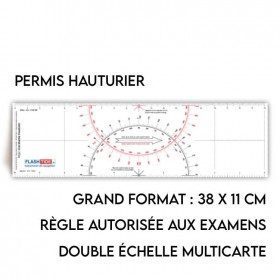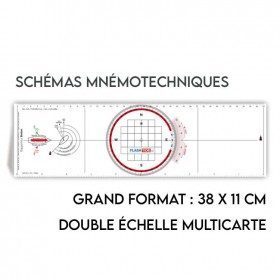Cras Rule or Breton Reporter?

This question is often asked when embarking on a course such as the Offshore licence: should you use a Cras ruler or a Breton protractor? What are the advantages of one over the other?
The Cras ruler
It consists of two half protractors on a transparent support allowing to trace or measure any heading or route on the chart. The main advantage of this ruler is its precision when you master its use perfectly! On the other hand, the reading and use of the original Cras model is made difficult in the overlap area of the two protractors. Fortunately, at Flash-Tide instruments we have redesigned several improved models of the cras ruler to make it easier to use for novice navigators: overlapping area layout, three-colour printing, etc...
It is true that learning how to use it may put off some apprentice sailors, but it is nevertheless very useful to master it as many French houseboats are still equipped with this ruler. With the advent of electronics, mastering the traditional techniques remains important, if only to be able to prepare a navigation !
The cras ruler is the emblematic ruler of the French Navy because it was developed at the beginning of the last century by theFrench Admiral Jean Cras, who was also a music lover and a well-known composer in his time. Widely diffused in the military navy, it quickly took its marks in the merchant navy and then in yachting and pleasure sailing because the trainers in these fields were often former professionals
Use of the Cras ruler
The Breton protractor
The Breton protractor was developed in the 60's by Yvonnick Gueret based on a model originally used by the merchant navy and then the US civil aviation. Today, this model is predominant in the Anglo-Saxon yachting industry. Indeed, with the reduction in the size of the chart tables in live-aboard yachts, the traditional parallel rule has been abandoned in favour of protractor rules.
By simplifying and rationalizing its manufacture, the disc protractor quickly became popular in France and also in England. It is composed of a mobile heading rose on the axis of the ruler. The great advantage of this model is the simplicity of reading angles or tracing routes or bearings, with less risk of error and easier learning for users.
Some instructors reproach the disc protractor for its lack of precision due to the mobility of the rose: in reality, it is only necessary to be precise in handling the ruler. Today, many candidates for the offshore licence pass their exam with a Breton protractor and many school boats are evolving and now work with a disc protractor New Breton Protractor or Brocémer ruler.
Using the Breton protractor
Linked products








 By Marie de Picksea
By Marie de Picksea